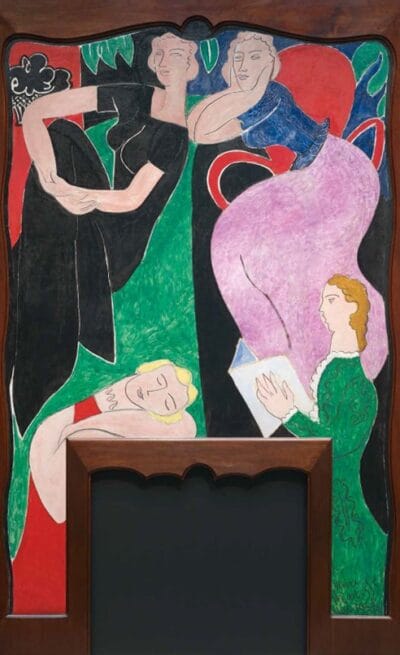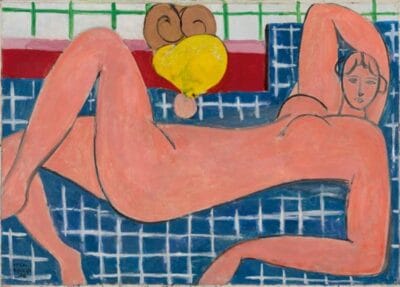When Henri Matisse (1869-1954) was commissioned to decorate the foundation of the collector Albert C. Barnes, he had just returned from several months of travel in the United States and Tahiti. Retrospectives of his work multiplied while he struggled to paint canvases. However, he worked tirelessly on the production of drawings, engravings and sculptures, and then on the composition of The Dance, a monumental mural work to which he devoted three years (1930-1933). The painter researched, explored and invented new methods such as paper cut-outs. His meeting with Lydia Delectorskaya, who became his assistant and model, opened a new prolific period in painting.
At the turn of the 1930s, Cahiers d’art published articles on Matisse’s current and previous work, illustrated with numerous reproductions of his artworks. By publishing engravings and drawings as they were produced, alongside the work of artists such as Pablo Picasso, Fernand Léger and Vassily Kandinsky, the magazine placed Matisse’s work in the artistic trends of his time.
1926
Matisse worked and lived in Nice where he devoted himself to the Odalisques series, paintings of female nudes in an oriental setting, after the model Henriette Darricarrère. In April, he agreed to contribute to the magazine created by Christian Zervos, Cahiers d’art, whose inaugural issue reproduced one of his lithographs, marking the beginning of an ongoing collaboration. In October, Paul Guillaume exhibited three works from Matisse’s radical 1910s period inspired by Cubism, including Bathers at the River (1909-1917).
1927
An important retrospective was organized in New York by Pierre Matisse, son of the artist and art dealer. In France, several solo and group exhibitions took place in Paris, at the Bernheim-Jeune Gallery, at the Salon des Indépendants and at the Salon des Tuileries. At the Salon d’Automne, Matisse presented two paintings, including Odalisque à la culotte grise. He completed Femme à la voilette, begun in 1926, the last painting made after the model Henriette Darricarrère. The work resounds like a double farewell – to a woman and to a pictorial style – and announces the period of doubt of the 1930s.
1929

Matisse writes to his daughter Marguerite: “I work a lot, but far from painting. I have set myself up several times to do something, but in front of the canvas I have no ideas – whereas in drawing and sculpture it works like a charm”. He made a great many engravings. Nineteen of them are reproduced in the issue No. 7 of Cahiers d’art, and the Bernheim-Jeune gallery organizes the exhibition “Forty original lithographs by Matisse”. That same year, he completes the sculpture Grand nu assis on which he has been working since 1922.
1930
On February 26, 1930, Matisse embarked from Le Havre to Tahiti. First stop, New York: “I am amazed at the arrival in the port of New York and all that I have seen so far, the power of human effort that I feel there is comforting. Now I’m afraid I’ll find the sweets of Oceania dull. He crossed the United States by train to reach San Francisco, which he left on March 19th to Tahiti, where he stayed until June. He produced few works during this trip: a pochade, a series of drawings and photographs. In September, he returned to the United States and met the collector Albert C. Barnes, who commissioned him to paint a mural for his foundation in Merion, near Philadelphia.
1933
In January, Barnes travels to Nice to see The Dance in the Studio and approves of the work. In February, Goyo, a house painter, came to help the artist transpose the paper cut-outs into solid colors. In May, Matisse traveled to the United States with The Dance to install it at the Barnes Foundation. He wrote to his friend, the artist Simon Bussy, “It is a splendor that one cannot imagine without having seen it. In the fall, Matisse took over the first unfinished decoration in order to finish it. He returned to easel painting, painted the Nude with a Bathrobe and painted his first portrait of Lydia with a blurring technique.

1935
Lydia poses for many paintings for which she is the model. She also begins to record the dates of her painting sessions, making it possible to follow the work in progress more closely.
On April 29, Matisse begins the Large Reclining Nude (Nu rose), using the cut-out gouache paper technique to work on the composition. The painting kept him busy for several months and on September 16, he wrote to his son Pierre: “It has already changed a lot. I am killing myself on it. It is curious that for some time now it is the colored vision that gives me the most trouble to realize. Is it that after having worked on the drawing and the composition I have dried up a bit on this side? In the fall, an illustrated version of Ulysses, by the Irish novelist James Joyce, was published.
Musée de l’Orangerie
Jardin des Tuileries, 75001 Paris, France
